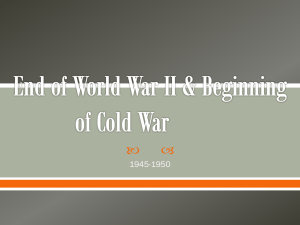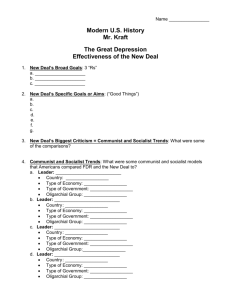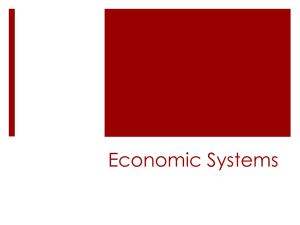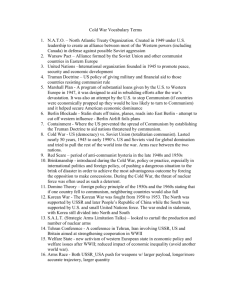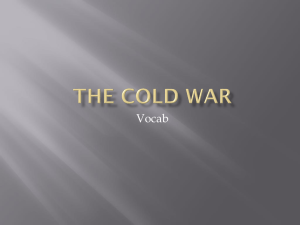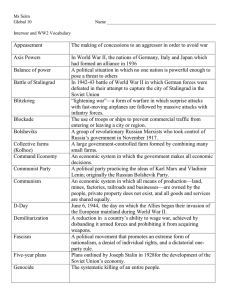The Twentieth Century: International Relations since 1919 Core Study
advertisement
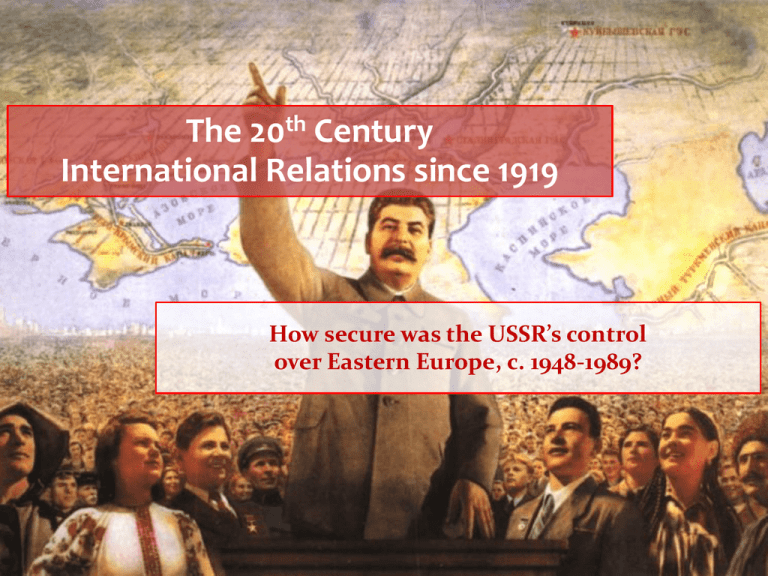
The 20th Century International Relations since 1919 How secure was the USSR’s control over Eastern Europe, c. 1948-1989? Framing Questions Why was there opposition and resistance to Soviet control in Hungary in 1956 and in Czechoslovakia in 1968, and how did the USSR react to this opposition? How similar were events in Hungary in 1956 and in Czechoslovakia in 1968? Why was the Berlin Wall built in 1961? What was the significance of Solidarity in Poland for the decline of Soviet influence in Eastern Europe? How far was Gorbachev personally responsible for the collapse of Soviet control over Eastern Europe? Map of the Eastern Block Stalinism The Soviets called the political economy that developed within the USSR “really existing socialism,” an ambiguous phrase implying there might be other and better kinds of socialism but, in practice, this was the only kind actually functioning. The Soviets referred to the USSR and its Eastern European satellites as the “socialist camp.” the socialist camp was to achieve technological modernization and industrial revolution through centralized state economic planning aimed at the ultra-rapid construction of the basic industries and infrastructure essential to a modern industrial society. The socialist camp’s nonmonetary allocation of rationed necessities to the people in kind— bread, clothes, bus tickets— embodied a spartan utopian ideal. And it did improve the standard of living of the lower class. The primary goal of “Let’s Carry Out the Five Year Plan in Four Years!” The socialist camp economically Very little information was and politically formed a separate and self-contained region of the world. Two-thirds of the exports of states within the socialist camp went to other socialist camp states; only 4 percent of the foreign trade of non-socialist camp states entered the socialist camp. The socialist camp followed a course of self-contained development, in virtual isolation from the world economy. allowed to enter or to leave the socialist camp. Only authorized or permitted information was available to the citizen. The possession of any other kind was punishable by law. There was little movement of people: emigration and temporary travel to non-socialist states were strictly controlled, and at times impossible. Even travel to other socialist states was restricted. Soviet Citizens Reading Pravda (“Truth”) The reason for the segregation of the socialist camp was political. The socialist camp pursued (in theory) a global revolution. The capitalist world sought to prevent socialist subversion and to destroy the socialist camp. The Cold War froze economic and political relations between East and West. systems of Eastern Europe, modeled on that of the USSR were based on a strongly hierarchical and authoritarian single party, which monopolized state power, operated a centrally planned command economy, and imposed a single mandatory Stalinist ideology. The command economy required command politics based on power, terror, and fear, the avoidance of risk, and a firm commitment to achieving communism in a distant future. A byproduct of command politics was paranoia. The political World Festival of Youth and Students (East Berlin, 9 August 1951) Josef Stalin (the “man of steel”) was an autocrat of exceptional ferocity and ruthlessness. Stalin manipulated terror on a universal scale. Stalin coerced the middle and working classes to sacrifice for the sake of rapid modernization. Stalin’s centralized command economy was closer to a military operation than to an economic enterprise. The Stalinist system turned farmers into serfs and relied on a prison labor force of up to 13 million (the Gulags). to impose total control over all aspects of its citizens’ lives and thoughts, all their existence being, so far as possible, subordinated to the achievement of the system’s objectives, as defined and specified by the supreme authority. Stalinism’s pragmatic intolerance transformed socialism into a secular religion, worshipping the leaders of the Communist Party and branding dissenters as heretics to be eliminated. Stalinism turned socialism into a non-hereditary monarchism. Stalinism attempted Stalin Lying in State (1953) At first, Stalin prioritized basic heavy industries and energy production —coal, iron and steel, electricity, and oil, but as the Cold War developed, the arms race took precedence. Production targets were set without consideration of costs or cost effectiveness. As urgent orders came from above, a system of crisis management developed. Stalin “stormed”— deliberately setting unrealistic targets to encourage superhuman efforts; Nikita Khrushchev vainly sought a way of making the system work in some other way than as a response to “shouting.” Decisions were increasingly concentrated at the apex of the Soviet system. The drawback of these procedures was inflexibility and an enormous bureaucratization of the economic and political system. By the late 1930s, there was one administrator for every two blue-collar workers. Stalin’s Great Terror may have been a desperate attempt to reduce the bureaucracy. After Khrushchev was removed from power in 1964, the bureaucracy expanded unchecked, contributing to economic stagnation. Soviet Caricature of the Bureaucracy (c. 1986) The socialist camp was not totalitarian. It did not exercise “thought control.” It did not attempt “thought conversion.” Rather, it depoliticized its population. Most citizens in the socialist camp had no interest in the official doctrines of the state, which remained irrelevant to them. Officially, the socialist camp was “monolithic,” but dissent dominated the arts, and it was uncertainly tolerated in the politics of communist reformers. the economies of the socialist camp grew considerably faster than those of the capitalist camp, so much so that both Khrushchev and Harold Macmillan believed that socialism would outproduce capitalism within the near future. It did not, however, as the costs of the Cold War arms race and an ossified bureaucracy were to bankrupt the Soviet economy. After WWII, Macmillan and Khrushchev (23 February 1959) The command economy of the socialist camp worked, and, generally, the socialist state commanded the loyalty of the people. The system kept the consumption of the people at rock-bottom: in 1940, the economy produced only a little over one pair of footwear in all for each inhabitant of the USSR. While inefficient and wasteful, the system guaranteed the people a social minimum above subsistence and it avoided the economic depressions of the capitalist business cycle. In the socialist camp, people enjoyed work, food, clothes and housing at controlled (subsidized) prices and rents, pensions, health care, and a rough equality until the system of rewards by special privileges for the nomenklatura—party administrators—got out of hand after Stalin’s death. The people also had access to education and social mobility. Farmers, however, did not enjoy an increased standard of living because Stalinism based industrialization on the backs of agricultural workers. Socialist collective farming was highly inefficient, requiring the socialist camp to import food. A Soviet Medical Student Shopping (1963) The Soviet economy favored capital goods over consumer goods. The standard of living grew strikingly in the socialist camp from 1940 to 1970, but this was because of a black market economy. The population spent much of its income in the black market economy and as “tips” to ensure service. in 1953, the leaders of the socialist camp reached a tacit understanding to put an end to the bloody purges and to empty the Gulags. While the USSR remained a society that treated its citizens badly by Western standards, it no longer imprisoned or killed its citizens on a massive scale. Crime and violence became relatively rare occurrences, making the socialist camp one of the safer places to live. Still, the socialist camp remained under the control of police states governing authoritarian and unfree societies, in which arbitrary imprisonment and internal exile continued. After Stalin’s death State Security Committee Building (22 August 1991) Stalinism in Eastern Europe The communist states, which came into being after WWII, were controlled by communist parties formed or shaped in the Stalinist mould. These states were characterized by a one party political system with highly centralized authority structures; officially promulgated cultural and intellectual truth determined by political authority; central stateplanned economies; and, strongly profiled supreme leaders. governments were compelled to follow the Soviet example, for instance, by organizing show trials and purges of local communists, a matter for which native communist parties showed no enthusiasm. Poland and East Germany managed to avoid the purges, neither killing nor handing over to the USSR any local communist leaders. Local Secretary of the Communist Party of East Germany Walter Ulbricht (c. 1961) In Hungary, Poland, and Romania, Stalinism was imposed exclusively by force, but in the rest of Eastern Europe, Stalinism came into being through local communist parties. For example, in Czechoslovakia, the communist party won 40 percent of the vote in the 1947 election, reflecting its genuine strength. But even in the countries in which Stalinism was forcibly imposed, it enjoyed temporary legitimacy and support. the idea of socialism was popular among the young and among intellectuals, not only because the communists had stood against the fascism of Germany and Italy. The success of Stalinism at rebuilding Eastern Europe extended its appeal to other social groups. The more agrarian countries of Eastern Europe, such as Bulgaria, advanced most rapidly. In contrast, the USSR pillaged the more advanced countries, such as East Germany, making Stalinism less appealing in these societies. After WWII, Czech Workers Demonstrate for Socialism (October 1945) Whether created by the Red Army or by homegrown communist parties, the Stalinist states of Eastern Europe formed a single bloc led by the USSR. Stalin believed he could rely on the loyalty of local communist parties, and he was surprised when the Josip Broz Tito (Life, 13 September 1948) communist leaders of Yugoslavia resisted Soviet directives to the point of an open breach in 1948. Stalin’s reaction was to extend purges and show-trials to the remaining Soviet satellites. The loss of Yugoslavia did not affect the rest of the socialist camp. David Low’s “Problem Child” (The Evening Standard, 25 August 1948) After the 1948 break between the USSR and Yugoslavia, prominent local leaders in Hungary (László Rajk) and in Bulgaria (Traicho Kostov) were executed in 1949. Trial of László Rajk (1949) In 1952, an implausible mass trial of leading Czech communists, with a markedly anti-Semitic undertone, decimated the old leadership of the local party. Cartoon Satirizing Rudolf Slánský’s Execution (1952) Challenges to Stalinism within the socialist camp arose in East Germany, Czechoslovakia, and Hungary because these three states were less agrarian and more economically developed than the other Soviet satellites. These was resistance both to the Russian counterparts were. Having a long history of revolutionary and democratic labor movements, they were independently minded. On the other hand, Stalin believed that only he knew the way forward and that only he was sufficiently determined to pursue it. replacement of private property and management by public property and management and to the replacement of the market and its price-mechanism by state regulation and pricing. Another reason why opposition to the Soviet system arose in Eastern Europe was that many Eastern European socialists were much more radical than their Head Knocked off a Statue of Stalin (Czechoslovakia, 1956) The Hungarian Revolution of 1956 The socialist camp did begin to fall apart after Stalin’s death and in particular after the Twentieth Congress of the Communist Party of the Soviet Union in 1956, when the Stalinist era was officially criticized. Khrushchev’s secret speech leaked, breaking the “monolithic” socialist camp. the Sovietdominated region of Europe were immediate. Within a few months, a new, reforming communist leadership in Poland was peacefully accepted by Moscow. In Poland, agriculture was de-collectivized but did not become more efficient. Polish leaders recognized the strength of the working class created by industrialization. In fact, an industrial movement in Poznan had brought the new leadership to power. The effects within Poznan Workers Demand Bread (1956) From 1956 until the triumph of Solidarity at the end of the 1980s, Polish politics and economics were dominated by the confrontation between the regime and the working class, which set out to organize itself, ally itself with intellectuals, and to form a political movement. Rather than being anticapitalist, however, the workers of Poland were anti-socialist. Typically, the confrontations were over government efforts to reduce the heavy subsidies on basic living costs by raising prices that were met by strikes creating political crises. in Hungary, a revolution broke out. Hungarian communist reformer Imre Nagy announced the end of one-party rule, which the USSR might have tolerated. Nagy also announced that Hungary would leave the Warsaw Pact and become a neutral country, which the USSR would not tolerate. Meanwhile, Imre Nagy The revolution was suppressed by the Red Army without Western interference. By 1956, Cold War relations had stabilized, and the capitalist camp did not exploit this major crisis within the Soviet bloc (except for purposes of propaganda). Newsreel Coverage of the 1956 Hungarian Revolution The leadership imposed by the Soviets after the defeat of the 1956 revolution was genuinely reformist and effective. In effect, János Kádár achieved Nagy’s objectives within the limits of what the USSR would regard as acceptable. Kádár systematically liberalized the regime, successfully conciliating the opposition until the 1980s. Victor Weisz, “Bah! Counter-revolutionaries!” (Daily Mirror, 1956) János Kádár The Berlin Wall In 1958, a huge missile gap existed between the USA and the USSR, overwhelmingly favoring the USA. Khrushchev, however, tried to use the successful launch of the world’s first satellite, Sputnik, as a way to bluff US President Eisenhower into thinking that the USSR had a massive strategic force. With the USSR losing the arms race, Khrushchev feared that West Germany would obtain nuclear weapons and that the Soviets would not be able to respond, so he proposed that central Europe should be designated a nuclear- free zone. Eisenhower refused, so Khrushchev issued an ultimatum. Calling West Berlin a “malignant tumor” inside the Communist bloc, he demanded the Western powers evacuate the city within six months. Eisenhower threatened to use nuclear weapons to protect Berlin, but he also invited Khrushchev to visit the USA. Cold War relations briefly thawed after Khrushchev’s American tour, but on 1 May 1960, an American U-2 spy plane was shot down over the USSR, reigniting Cold War tensions. Berlin. In the 15 years following WWII, over 3 million people had emigrated to the Federal Republic of Germany (West Germany) from the German Democratic Republic (East Germany) via Berlin. Khrushchev U-2 Pilot Gary Powers on Trial in Moscow (1960) In 1961, Khrushchev renewed his demands that the Allies turn West Berlin over to the Communist East German regime. Khrushchev was concerned about ending the evergrowing exodus of better-educated East Germans to the West via met with US President John F. Kennedy in Vienna on 4 June 1961. Khrushchev threatened to move on Berlin. Kennedy warned that the USA would tolerate no changes to the balance of power in Europe. Khrushchev resolved the crisis by building the Berlin Wall on East German territory, presenting Kennedy with the choice of accepting the wall or of invading East Germany. On 13 August 1961, Erich Honecker, the Security Secretary of the Communist Party’s Central Committee, ordered East Berlin to be blocked off from West Berlin by means of barbed wire and antitank obstacles. Streets were torn up, and barricades of paving stones were erected. Vienna Conference and Berlin Wall People living in East Berlin and the Newsreel Coverage (January 1962) German Democratic Republic were no longer allowed to enter West Berlin. This included the 60,000 East Germans who had been working in West Berlin. The Berlin Wall closed the last border between the East and West. Over the next few months, East German construction workers began replacing the provisional barriers with a solid wall. When completed, the Berlin Wall was 166 kilometers long and cut through 192 West Berlin streets, 97 of them leading to East Berlin and 95 leading into East Germany. The wall was rebuilt in 1965. This second wall consisted of concrete slabs between steel girders and concrete posts with a concrete sewage pipe on top of the wall. The Berlin Wall was heavily guarded, and around a hundred people were killed and many more were seriously wounded trying to cross the wall. The West Germans were furious with Kennedy for allowing Khrushchev to build the Berlin Wall. Nevertheless, Kennedy made a triumphant visit to West Berlin and delivered a speech on 26 June 1963 in front of the Berlin Wall. Similarly, US President Ronald Reagan delivered a passionate speech in front of the Berlin Wall on 12 June 1987. The Wall (Hearst Metrotone News, 1962) John F. Kennedy’s Berlin Speech (26 June 1963) Ronald Reagan’s Berlin Speech (12 June 1987) By October 1989, Hungary and Czechoslovakia had overthrown their Communist rulers. East Germans were again escaping to West Germany in large numbers through Hungary and Czechoslovakia. The Berlin Wall was no longer serving its purpose. On 9 November 1989, the East German government decided to recognize the new reality by opening the Berlin Wall. Within 72 hours, the bloodstained symbol of the Cold War was being battered down by giant jackhammers, and by small hammers wielded by aspiring capitalists who sold small pieces of the wall to American and European buyers. Berlin Wall Falls (BBC, 9 Nov 1989) Berlin Wall Memorial (c. 2011) The Prague Spring of 1968 Because of the ruthless purges of 1952, de-Stalinization proceeded cautiously and tentatively in Czechoslovakia. In the 1960s, the process suddenly accelerated for two reasons. The first was that the Slovaks were increasingly dissatisfied in the bi-national state. Alexander Dubček, elected General Secretary in a party coup, was a Slovak opposition leader within the local communist party. reason was that the youth of Czechoslovakia were part of a worldwide 1968 movement transcending the capitalist and socialist camps, desiring neither capitalism nor “really existing socialism” but utopian socialism. Alexander Dubček (1968) The second “The Year the World Caught Fire” (2008) The communist party in Czechoslovakia had enjoyed genuine mass support before the Nazi occupation, during which it was the heart of the resistance to Nazi Germany. As such, the communist party attracted young idealists committed to selflessness, and it retained its popular support after WWII. The communists of Czechoslovakia risked torture and death in 1968 because their hopes for utopian socialism forced them to rebel against the profoundly shocking realities of Stalinism. for economic reform, for economic decentralization, for rationality and for flexibility in the economy, when coupled with demands for intellectual and political liberalization became explosive. Stalinism had been harsh and long lasting in Czechoslovakia, accounting for why the demands for change were so strong. The call Czech Students Demonstrate (Goethe Institute, 21 August 1968) Preceded and accompanied by politico-cultural ferment and agitation, the Czech Communist Party initiated reform from above in an “Action Program” that moved the one-party dictatorship towards a pluralist democracy. Dubček repeatedly made clear Czechoslovakia’s intent to remain within the Warsaw Pact, hoping to avoid the fate of Hungary’s Nagy. But the reform in Prague threatened the entire socialist camp. Czech Students Argue with Soldiers (1968) The regimes of East Germany and Poland, having no mass support, feared internal destabilization from the Czech example. These regimes bitterly criticized Dubček. The Prague Spring (1968) Throughout Eastern Europe, however, local communist parties enthusiastically supported Dubček. Within the Soviet bloc, the Hungarians (who were successfully reforming their society) and the Romanians (who were increasingly nationalistic) backed Czechoslovakia. From outside, the Yugoslavians extended their assistance. It seemed as if Moscow would lose its control of the socialist camp. Moscow, the Soviet leadership debated and hesitated to act, but ultimately the Soviets decided to overthrow the Prague regime by force. The Prague Spring (British Pathé, 1968) In “Wake up Lenin. Brezhnev has gone mad.” The re-imposition of Stalinism in Czechoslovakia marked the end of the socialist camp. The USSR was able to hold onto its Eastern European satellites for another 20 years but only by exercising force and by threatening military intervention. Moscow had given up whatever leadership it had retained in the international communist movement. After the invasion of Czechoslovakia, the Soviet leadership and the leadership of the local communist parties appeared to have lost any real belief in what they were doing. No one really believed anymore that the socialist camp would overtake and surpass the capitalist camp, or even keep pace. The developed, non-socialist economies grew and flourished in sharp contrast to the socialist economies. This was most apparent in the differences between stagnant East Germany and prosperous West Germany. The Soviet GNP, which had grown at an annual rate of 5.7 percent in the 1950s, fell to 3.7 percent in 1970, 2.6 percent in 1975, and 2 percent in 1980. The Prague Spring must be understood within the context of the global uprising of the youth in 1968. Around the world, not just in Czechoslovakia and not just in the socialist camp but in capitalist states as well, governments were repressing demands for utopia. Economic and Political Crises in the Soviet Bloc In the 1970s, the structural economic problems of “really existing socialism” became clear: productivity of labor, real income per head, industrial and farming output, capital investment, and GDP advanced slightly or fell. The nomenklatura of the Leonid Brezhnev era (1964 to 1982) represented the weaknesses of the self-serving party bureaucracy: incompetence and corruption. During the growth years, the socialist camp had exported machinery; during the decline, it exported primarily oil and gas, while importing machinery. Socially, life expectancy was not increasing, as it was in the West, and, at times, it was falling, contributing to disillusionment. “Let’s Carry Out the Five Year Plan in Four Years!” The Soviet system operated as a system of patronage, nepotism, and bribery. Reform, except in Hungary, was abandoned after the defeat of the Prague Spring. The regimes kept discontent in the 1970s in check by subsidizing consumer goods, which did give the working class a higher standard of living but was only a short-term solution that contributed to longterm problems. For example, instead of reforming the collapsing agricultural system, the socialist camp turned to buying wheat on the world market. booms and slumps, such as that caused by the 1973 oil crisis: oil prices rose from $2.53 per barrel in 1970 to $41.00 per barrel in 1980. As an oil exporter, the USSR benefited greatly from rising prices, but the Soviets used oil revenues to avoid rather than to solve underlying economic problems. As the socialist camp integrated more into the world market, it became vulnerable to capitalist Nicholas Garland, “Vote Brezhnev…Or Else” (Daily Telegraph, 4 March 1981) Poland and Hungary accepted huge loans from the OPEC states to improve their standards of living, falling into insurmountable debt that would create financial crises in the 1980s. Even as Romania’s oil fields dried up, the socialist camp did not economize despite rising oil prices. While oil consumption in the West fell by 40 percent, it fell by only 20 percent in the Soviet bloc. Production costs in the socialist camp’s inefficient industries rose with the price of oil. An acute energy crisis in the early 1980s caused shortages of food and consumer goods (except in Hungary where continued borrowing resulted in inflation and rising wages). At the same time, Brezhnev decided to close the missile gap with the USA and actually to compete with the USA, breaking the tacit agreement of the Cold War that the superpowers would not directly confront one another. Empty Grocery Store (Warsaw, 31 July 1981) The Stalinist regimes responded to the economic crisis by issuing strict orders and restrictions, which brought temporary relief, but in Poland and Hungary, the party was no longer in complete control and could not impose its policies. The communist parties of the Soviet bloc held onto illusory hopes of a return to economic growth, which only brought a return to economic crisis. problems of “really existing socialism” were even more difficult to overcome, leading to the collapse of the socialist camp in 1989-1991. After the Prague Spring, the communist regimes lost popular support (more so in Poland and Hungary and less so in Bulgaria). Hungary continued to go deeper into economic debt to buy the loyalty of the people. The other states relied on coercion and the threat of a Red Army invasion to maintain control. The political Queue for Cooking Oil (Bucharest, Romania, 1 May 1986) Solidarity in Poland In Poland, strong anti-Stalinist, anti-Jewish, and pro-Catholic nationalism threatened the regime, where Polish workers organized and used strikes as a weapon to control the policies of the Polish regime. In 1978, Karol Wojtyla became the first Polish pope (John Paul II), adding popular pressure on the Polish regime. Pope John Paul 1 and Cardinal Karol Wojtyla (4 September 1978) In the summer of 1980, the communist regime reduced food subsidies, leading to labor unrest. On 13 August, electrician Lech Wałęsa led a strike of the workers of the Lenin Shipyard in Gdańsk, demanding not only better working conditions but also government reforms. Lech Wałęsa (c. 1980) Management met the working The workers followed and pay demands of the strikers within 3 days, but the strikers continued their strike, pressuring the government to commit to 21 reforms. The government agreed to the demands of the striking workers on 31 August (the Gdańsk Agreement). up their victory with a trade union congress in September at which they created the national, independent and selfgoverning trade union Solidarność (“Solidarity”). One-third of the Polish workforce—10 million workers—joined Solidarity, and elected Wałęsa president of the organization. Signing the Gdańsk Agreement (31 August 1980) Polish Workers Sit on a Wall (c. 1980) On 13 December 1981, General Wojciech Jaruzelski declared martial law in Poland, arrestingWałęsa and other Solidarity leaders. Solidarity was driven underground when it was outlawed on 8 October 1982, although Wałęsa was released from prison the following month. Solidarity’s underground activities forced the ruling Polish General Wojciech Jaruzelski United Workers’ Party to hold semi-free elections in June 1989, in which Solidarity won all seats not reserved for the communists. Wałęsa, opposed to cooperating with the communists, ran on an anti-communist platform in the presidential elections of 1990. He won the 9 December election, becoming Poland’s first president to win a multi-party election. Lech Wałęsa (c. 1990) The Collapse of the Soviet Union The 1980 triumph of Solidarity demonstrated two realities: the Communist Party in Poland faced a terminal crisis but mass agitation could not overthrow it. Fearing a Red Army invasion, the Church and the Communist Party agreed to allow the Polish Army to impose martial law to crack down on Solidarity. The police temporary reestablished order in Poland. The Communists in Poland, however, realized that without a Red Army invasion, the Party would eventually have to abdicate. in Poland, slowly and reluctantly understanding that the USSR under Mikhail Gorbachev (19851991) would no longer intervene as it had in Prague in 1968. The other regimes in the socialist camp fearfully watched events Mikhail Gorbachev An idealist, Gorbachev was still committed to communism. He opposed the corruption of the Communist Party. Gorbachev wished to preserve the USSR, but he realized that not only structural inefficiency and inflexibility but also military spending would doom the USSR. Simply, the USSR could no longer afford to maintain the socialist camp through military interventions. War in Afghanistan (prolonged by unlimited US assistance to the Mujahideen) was draining the USSR’s economy. Afghanistan became the USSR’s Vietnam, as the USA had intended. “You look very ‘tired,’ Comrade Gorbachev. Take a rest.” (Charles Griffin, 20 August 1991) Afghan Government and Soviet Troops (Afghan-Soviet War, 1 January 1988) Under the surface of the stagnation of the Brezhnev era, a few hundred self-co-opted upper class party leaders joined by educated and technically trained middle class managers (academics, intelligentsia, experts, and executives) had begun a process of criticism and self-criticism of the Stalinist party, state, and security and foreign services. The debates of the 1980s within the Soviet leadership were retrospective searches for an historical socialist alternative to Stalinism. This tiny group of dissenters responded immediately to Gorbachev’s call for glasnost (“openness, transparency, freedom of information”), a term first used by exiled Soviet dissident Alexander Solzhenitsyn in 1967. Alexander Solzhenitsyn Glasnost Editorial Cartoon Gorbachev radically changed Soviet policy. First, he decided unilaterally to withdraw from the Cold War. This made Gorbachev exceedingly popular in the West but increasingly unpopular in the East. Second, he informed the regimes of Eastern Europe that they would have to depend on their own resources (not the Red Army) to maintain their authority. Gorbachev’s perestroika (“restructuring”) was an attempt to introduce market pricing and calculations of profit and loss into the command economy, which would then make it easier to liberalize and democratize the political system. Gorbachev’s intention was to achieve a socialism better than “really existing socialism.” But, at the end of the 1980s, the communist system, which had held the USSR together, effectively abdicated and pre-Soviet tensions re-emerged. The political regimes of Eastern Europe as well as their social and economic systems collapsed. The self-segregation of the socialist camp crumbled, and the economies of the socialist camp began to integrate into the “There’s not much in the store, but it’s worth it to wait!” world economy. (Le Monde, January 1989) Reforming the political system was easier than improving the economic system. A new constitution separated the Communist Party from the state. Permanently loss-making state enterprises were permitted to go bankrupt. Black market operations were legalized. But the economy visibly worsened. The people were more interested in the day-to-day functioning of the economy than in who made political decisions (a Stalinist regime or a government of politicians periodically elected). The national economy disappeared, as local economies sought self-protection, selfsufficiency, or bilateral exchanges. Bartering replaced much of the cash economy. The declining economy created a dangerous situation. No one knew how to gain the advantages of capitalism without losing the advantages of socialism. Life after Communism (David Horsey, Seattle Post-Intelligencer, 1996) Three contradictions undermined Gorbachev’s reforms. First, only the Communist Party could change the system, but the Communist Party was the main obstacle to change. Second, political transparency limited the authority of the Communist Party to act, and democratizing the militarily oriented Communist Party did not make it more efficient, particularly when there was no alternative civilian system to take its place. Third the working class was asked to sacrifice without immediate benefit. Why, Soviet workers argued, should they raise their productivity to earn higher wages unless the economy produced the consumer goods to buy with these higher wages? But how would these goods be produced unless Soviet workers raised their productivity? These contradictions led not to reconstruction, but to collapse. Soviet Hand-Painted Poster (c. 1985) The people of the USSR did not support Gorbachev’s reforms. For them, unlike the people of Eastern Europe, the Soviet regime was their regime. It provided them with a guaranteed livelihood and comprehensive social security at a modest but real level, a socially and economically egalitarian society, and the “right of idleness.” For the Russians, the Brezhnev era had not been one of stagnation but the best era ever known. This meant that the separatist movements in the socialist camp began in territories the USSR had acquired after WWI and WWII (the Baltic States, the Ukraine, and Bessarabia). There had been no Russian youth movement in 1968, and Gorbachev’s 1985 reform movement did not come from below. Fast Food in the USSR (1989) Passengers on Board of an Aeroflot IL-62 (1981) The collapse of the USSR and of its Eastern Europe satellites came as a surprise. Glasnost replaced the authority of the Communist Party with pluralist electoral politics, while perestroika destroyed the economy without providing an alternative. Standards of living fell dramatically. The USSR had been held together by the party, the army, the security forces, and the command economy. Without these, there was political chaos. Local nationalist movements fractured the USSR. At first, nationalism was directed not against Moscow but against conservative local leaders. As communist reformers turned to nationalist groups for support, nationalist movements gained strength. Boris Yeltsen, an old party boss adept at manipulating the media, transformed the Russian Federation into a republic, bypassing Gorbachev’s Union, leading to the disintegration of the USSR in 1991. Within Russia, Gorbachev was seen as a failure, who destroyed what he wanted to reform and was destroyed in the process. Boris Yeltsen Dancing (1996) The Collapse of Stalinism in Eastern Europe Between August and December 1989, communist power abdicated or ceased to exist in Poland, Czechoslovakia, Hungary, Romania, Bulgaria, and the German Democratic Republic (soon to be annexed by West Germany). Only in Romania did this involve violence. None of these communist regimes was overthrown. Except in Poland, there were no threatening internal forces, and in Poland, a negotiated process of compromise and reform brought about regime change. threat to the Eastern European communist regimes came from Moscow, where Gorbachev said the Soviets would not intervene as in 1956 and in 1968 to rescue them. Gorbachev did not impose reform on hardliners, such as those in Czechoslovakia and the GDR, but he did praise reformers in Poland and Hungary. The real Hungary Opens Its Borders to the West (1989) In Eastern Europe, the middle and lower classes had accepted Stalinism, preferring to live quiet lives and showing outward loyalty to a system that did not believe in because they saw no alternative. The withdrawal of the USSR provided the people with an opportunity. 21 December 1989, Romanian President Nicolae Ceaușescu was publicly booed, and a spontaneous rebellion began. The Romanian regime resisted briefly, resulting in the 25 December execution of Ceaușescu. All the other East European regimes decided to abdicate quietly without resorting to military force to maintain their authority. Not believing in the system either, the leaders of the communist regimes were not willing to risk death to defend it. Young Europeans had forgotten the communist resistance to fascism in WWII and the hope for a better life that communism represented. On Execution of Nicolae Ceaușescu (25 December 1989) In Eastern Europe, communist regimes could no longer provide a guaranteed livelihood or a real level of social security. Eastern Europeans decided to join the capitalist camp, which provided some with a higher standard of living but denied many any livelihood at all and provided no real level of social security. collapse of communism in the Soviet Bloc demonstrated how superficial its imposition had been. Party members had been loyal communists, but the majority of the people were not. The loyalty of the people to the communist regimes depended on standards of living. So long as standards of living improved, the regimes remained popular; conversely, once standards of living started to decline, leaders lost faith in the ability of communism to provide a better life in the future. “Really existing socialism” ended. The rapid Václav Havel and the Velvet Revolution (Czechoslovakia, November 1989)
